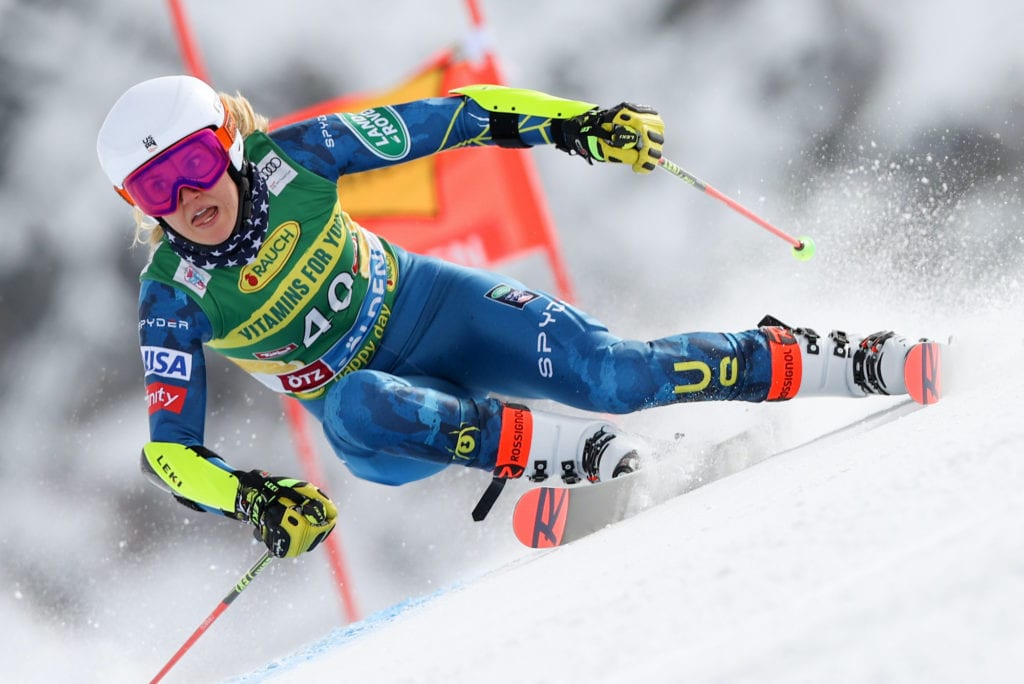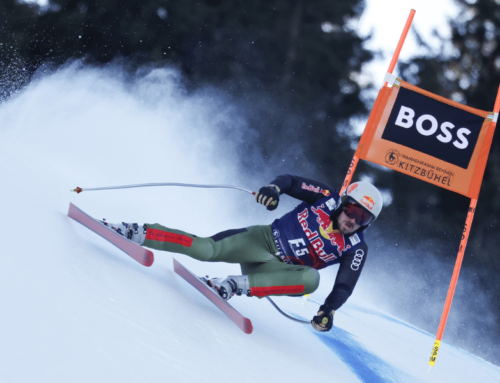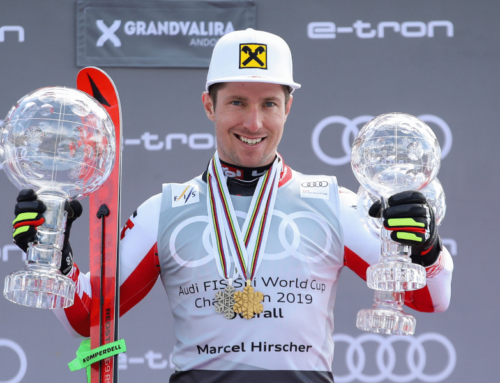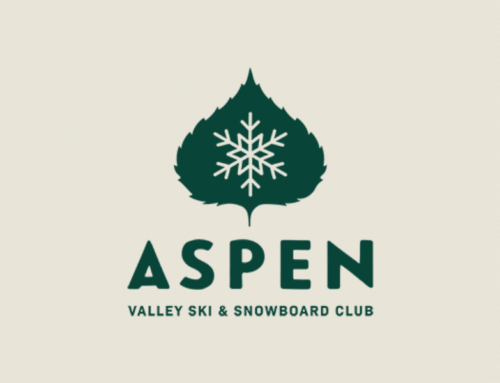Racers focus on ‘the skiing part’ as international travel gets complicated
Everyone in the international ski race community is aware that several scenarios could derail their season. But at the moment, such thoughts lie at the back of the mind for many. In spite of lockdowns and restrictions throughout Europe, ski training and race preparation is moving ahead with a feeling of relative normalcy for athletes.
“To be honest, the whole COVID fear and chaos, you don’t see it happening where we are,” says Paul Epstein, coach at Global Racing. “How everything is displayed in the news is different than how everything plays out in reality. I can’t say the pandemic has impacted us negatively at this point in terms of our ability to train. It’s just a bit of uncertainty. We are planning on coming back to Italy, so now it could be that Italy shuts down the mountain here in South Tirol. But at this point, we haven’t missed any training.”
The Global Racing team is training a few kilometers from Soelden, Austria, where the 2020-21 World Cup opener went down as planned, albeit without a live audience.
“There basically was no crowd. Spectators were not allowed. There were a few VIP in the stands. I saw like 10 people,” Epstein said. “To be honest, it was kind of nice … more low key. Soelden can be chaotic and difficult to move around in a normal year.”
Nonetheless, shortly after the Soelden races, one of the Global Racing coaches came down with COVID-19, although Epstein doesn’t believe it was contracted in Soelden. Luckily, the symptoms, positive test and subsequent quarantine happened at a time when the coach was away from the team. Otherwise, anyone who had been in close contact (within six feet indoors for at least 15 minutes), in spite of getting a negative COVID, would also be required to quarantine for two weeks.
“The contact tracing part is a bit difficult for me to understand fully,” Epstein says. “If someone on our team tests positive and you’ve been near them, you have to be in lockdown for two weeks even if you test negative. That seems a bit unfair.”
No crowds … except for on gondolas and trams
In spite of the face-covering and quarantine mandates and precautions, which at the Soelden races, involved color-coded lanes and corrals indicating areas where members of only the same team could congregate, there have also been instances, particularly on gondolas and trams, where large crowds are crammed into a small spaces for several minutes.

“There’s not social distancing going on over here at all,” Epstein says. “In the gondola in Schnalstal, there’s 25 or 30 people going up on the tram in the morning. Everyone is wearing a mask, but in close quarters for five, six minutes. If you’re next to someone for three minutes who tested positive, who’s to say you couldn’t get the virus?”
As of Friday, Epstein said Schnalstal was only open to professional athlete groups and had begun requiring negative COVID-19 tests from the last 72 hours.
With new lockdowns in effect this week in Europe, those types of situations will likely go away. As of Tuesday, restaurants and shops once again closed in many areas of the Alps, as well as most ski areas. Only a select few are still allowing access for competitive athletes.
World Cups (as of now) are still happening
“I would say for the most part, I feel totally safe and comfortable,” says U.S. racer Nina O’Brien, who just returned to Soelden, where she finished 15th at the World Cup opener, to train before the upcoming World Cup slaloms in Levi, Finland, recently pushed back to Nov. 21-22 due to lack of snow and warm temperatures and the parallel events in Lech, Austria, now scheduled for Nov. 26-27.

“At the World Cup, I felt totally safe. There were tons of protocols at the venue,” O’Brien says. “Everyone had color-coordinated zones between athletes and FIS officials. You had to stand in your zone with no mingling. I can think of one instance in Saas Fee (Switzerland), when the gondola broke down and they redirected us to a different gondola. The younger athletes were all loading and it was a big crowd. In those situations, you’re wearing your mask and hoping for the best. But I’d say everyone is pretty respectful in general. They’re not up in your space as much as they would be normally in a Euro lift line.”
For athletes, other than the occasional crowd on a gondola or in a tram and getting to and from countries, training feels like business as usual.
“Originally, it was difficult to get approved for a visa and get over to Europe,” says Global Racing’s Brian McLaughlin, who has been in Europe training since September and hopes to improve his World Cup ranking after ending last season earlier than everyone else due to a knee injury. “Since then, the only other real issue was entering Switzerland. You are required to quarantine when entering Switzerland if you have been in a red zone, for example, the U.S., in the last 14 days. But it was easy enough to test into Austria, train there for two weeks, then enter Switzerland if you need to.”
World Cup athletes, coaches and service providers must provide a negative COVID test when arriving at a new venue and were all required test before the Soelden races.
U.S. Team has been investing big into virus testing
U.S. Ski and Snowboard has spent around a half a million dollars implementing COVID-19 testing measures for its athletes and staff. U.S. Team racers are required to take two COVID tests every week as well as travel and share condos with a smaller number of teammates than in a typical season. It’s all added up to higher costs for USSS.
“Especially with the current outbreak, the safety of our athletes is our top priority,” says U.S. Ski & Snowboard High Performance Director Troy Taylor. “I’d say the No. 1 challenge is entry requirements and specific health orders as related to traveling from the U.S. The common challenge we’re getting now is the outbreak within Europe and restrictions within specific European countries. The requirements traveling between Switzerland and Germany might change. All of the European Union countries could be changing requirements on a daily basis.”
Taylor points out that those who contract the virus can keep it in their system, displaying positive test results for months after the symptomatic and contagious stages have passed. For athletes traveling to Europe from the U.S. who have to present a negative test result within 72 hours of travel, this could sideline them for the season. Luckily, the U.S. Team’s many safeguards have so far been successful.
“We’ve trained in a lot of locations with no transmissions,” Taylor says. “We haven’t had any community spread or anyone spreading it beyond a roommate. We’re on heightened alert right now. You only travel in a car or eat with your condo people. We minimize the contact we have in our team environment. It comes down to a hundred or a thousand small decisions a day. It’s not easy.”
But the decisions, the stress of constant pivoting and planning in the COVID era for an already high-risk sport mostly fall on the shoulders of coaches and team organizers.
Extra moving parts
“Certainly, as the third wave hits and the pandemic progresses, it makes us all nervous,” Taylor says. “It’s a semi lockdown again. Ski areas [in Europe] are going to be closed to recreation and the public. Some of our sports have a small chance of needing helicopter trauma to an ICU center. In normal times, that’s our emergency action plan for every venue, but now we are making sure they have availability. We certainly don’t want to be a strain on that. We are working through a lot of those pieces. Like most people, we plan for the worst and hope to execute the best we can.”
At this point, athletes are protected from these types of stresses. They are simply riding the waves of the ever-changing tide.
“I would say from the athletic perspective, the biggest impact is not being able to work with our European coaches and technicians,” O’Brien says. “Entering Austria, our training plan is really loose. Usually we’re taking into account things like, where are snow conditions the best? Where is hill space available? Now, it’s where is it safe to go? Is it open? Even today, we’re not sure where we’re going next or if we can continue training at Sölden. For me, my goals are to do well at World Cups, get into the top 30, have good second runs and move up. If I were in charge of all the moving pieces, I’m sure I’d be a lot more stressed out. I’m doing everything I can in my control and power. My job is the skiing part.”





















